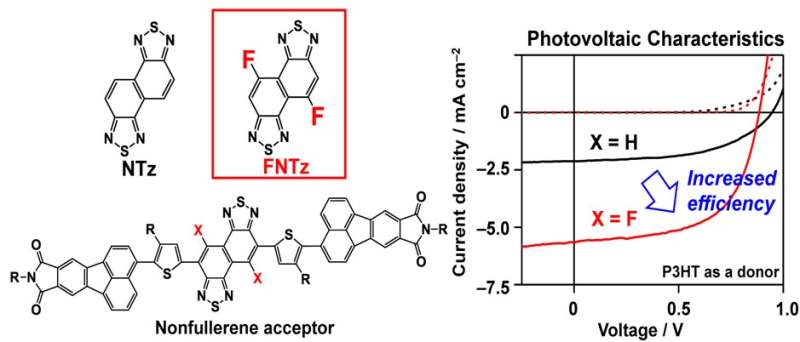Controlling organic semiconductor band gaps by electron-acceptor fluorination

Organic semiconductor materials have the potential to be used in innovative applications such as transparent and flexible devices, and their low cost makes them particularly attractive. The properties of organic semiconductor materials can be tuned by controlling their structure at the molecular level through parts of the structure known as electron-accepting units. A group of researchers centered at Osaka University has specifically tailored an electron-accepting unit that was then successfully used in an organic semiconductor applied in solar cell device that showed high photovoltaic performance. Their findings were published in NPG Asia Materials.
"Electron-accepting units are important elements of organic semiconductors," corresponding author Yoshio Aso says. "Through the controlled addition of electronegative fluorine groups to a widely used electron-accepting material, we were able to show precise control of the energy levels within the resulting semiconductor. This ability to tune the band gap translates to selectivity over the injection and transport of holes and/or electrons within the material, which is important in potential applications."
The fluorinated electron-acceptor unit was used to prepare a thin film solar cell that was compared with a cell based on a non-fluorinated analogue. The researchers found that the fluorinated material showed enhanced power conversion efficiency, up to 3.12%. The morphology of the fluorinated film was also found to be good, which supported the efficient charge generation and transport that is necessary for successful application.
"The more we are able to fine tune organic semiconductor behavior on the molecular level, the more possibilities there will be for demonstrating their macroscopic applications," co-author Yutaka Ie says. "It is our hope that the band gap control and high photovoltaic performance we have demonstrated will lead to our material being applied in devices such as organic light-emitted diodes, field-effect transistors, and thin film solar cells."
The straightforward demonstration of the link between high electronegativity, greater electron-accepting tendency, and enhanced semiconductor performance, highlights both the potential and versatility of organic semiconductors. Further elegant solutions such as this one could substantially broaden the range of ƒÎ-conjugated materials, and reinforce the case for organic electronics.
More information: Shreyam Chatterjee et al, Fluorinated naphtho[1,2-c:5,6-c']bis[1,2,5]thiadiazole-containing π-conjugated compound: synthesis, properties, and acceptor applications in organic solar cells, NPG Asia Materials (2018). DOI: 10.1038/s41427-018-0088-4
Provided by Osaka University




















